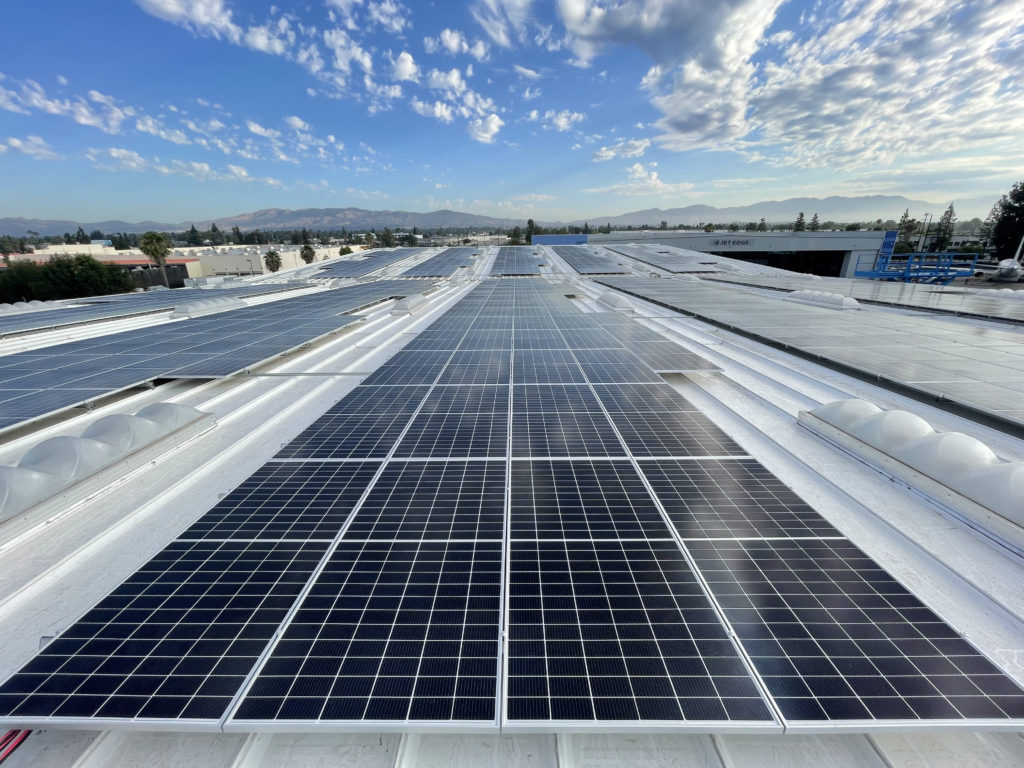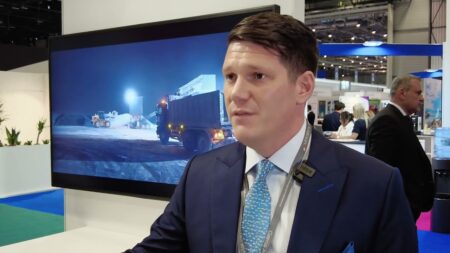Words by Paul Willis
As the reality of climate change hits home around the world business aviation is taking up the gauntlet of sustainability.
Much of the focus within the industry has been on the need to switch to sustainable aviation fuels. But while important, this focus neglects the measures business airports and FBOs can take to make their ground infrastructure and operations more sustainable.
For airports and FBOs looking to cut emissions the California-based Clay Lacy provides a useful case study. In the last two years Clay Lacy has invested heavily in making its building infrastructure and ground operations sustainable.
Among the projects undertaken by the company is the installation of a 500 kilowatt (kW), 30,000 square feet solar array at the company’s Van Nuys Airport headquarters. Completed in February last year the rooftop array will generate 750,000 kilowatt hours of electricity each year, saving 530 metric tons of CO₂ and cutting in half Clay Lacy’s energy bills at the airport.
The company is also in the process of constructing a new FBO facility at John Wayne Airport in Orange County which will be built according to the Institute for Sustainable Infrastructure’s (ISI) gold standard, says Clay Lacy’s senior vice-president for development and sustainability Scott Cutshall.
Other measures the company has taken says Cutshall, include “changing out almost all of our light bulbs with LED lights, replacing water fixtures – whether it be toilets or faucets – with low-flow water systems to reduce our water consumption and incorporating segmented recycling and trash at all of our facilities.”
Clay Lacy’s journey with sustainability began in 2019 with the creation of a company sustainability strategy.
According to Cutshall, the approach to sustainability can be summarized into four basic steps: measure, reduce, replace and offset.
He says, “Sustainability starts with measurement. You must first measure where you are to get your benchmark. The next step is to reduce – you try to reduce electricity consumption, water use, you try to reduce what you’re using and your emissions. Once you’ve reduced then you can look to replace what you use with more sustainable alternatives.”
As an example of a replacement, Cutshall points to Clay Lacy’s decision to switch all the ground service equipment at its Orange County location to either electric vehicles or to run off renewable diesel fuel, which has a lower carbon footprint than petroleum-based diesel.
The final step is to purchase carbon offsets for what remains after you have reduced or replaced. Carbon offsets are not a long term answer, but it is what is available today until more sustainable alternatives enter the market.
Cutshall identifies three factors driving Clay Lacy’s sustainability push: “We believe there will be regulations in the future we want to be ahead of. Secondly, we think it’s a value differentiator with our customers. As we go forward more people will be making decisions with sustainability in mind. Thirdly, we just feel it’s the right thing to do.”
Regulations
 Cutshall’s expectation of future regulations may well prove correct. In fact, some of those environmental regulations have already been introduced, especially in Clay Lacy’s home state of California, which has long been known for its progressive approach to environmental protection and green energy.
Cutshall’s expectation of future regulations may well prove correct. In fact, some of those environmental regulations have already been introduced, especially in Clay Lacy’s home state of California, which has long been known for its progressive approach to environmental protection and green energy.
“In California there’s a green building code standard that has come along in the last five years. It says that as developers we have to do certain things relative to the lighting and structure of new buildings,” says Curt Castagna, CEO of Aeroplex, the California-based aviation property development, consulting and management firm.
According to the California code new buildings must be fitted with LED motion-sensor lighting as well as have skylights integrated into the roof to enhance the availability of natural lighting. Castagna says, “It’s very common in California to have hangars where you don’t have to turn the lights on at all during the day because there’s so much light coming in through the skylights and side lighting.”
The roof design also needs to accommodate “a certain percentage of its area that can carry the weight of solar panels” even if the developer has no plan to install them. Meanwhile, the construction phase of the project must meet both state and federal regulations to ensure that its environmental impact is kept to a minimum.
Like fellow Californians Clay Lacy, Aeroplex unveiled a solar array earlier this year – a 1,000-panel, 55,000
square foot system on the rooftop of one of its buildings at Long Beach Airport, which it leases to the FBO Signature Flight Support.
The solar array cost around US$2 million to install and was part-financed with a three-year loan. Since the array generates enough power to supply all of the facility’s energy needs “once the loan is paid off we will be making money back on our investment because we will no longer have any utility costs,” says Castagna.
Self-sufficient
 Being able to generate their own power is likely to become more important for business airports as they pivot to accommodate the coming eVTOL aircraft revolution, believes Castagna. However, he notes that installing a solar array will not necessarily ensure energy independence. The power from most arrays cannot be used by the airport itself but is instead fed directly back in to the electrical grid.
Being able to generate their own power is likely to become more important for business airports as they pivot to accommodate the coming eVTOL aircraft revolution, believes Castagna. However, he notes that installing a solar array will not necessarily ensure energy independence. The power from most arrays cannot be used by the airport itself but is instead fed directly back in to the electrical grid.
He says, “There is a myth that if you put solar on your buildings the energy that is generated can be fed straight to EV charging stations. For that to happen you need a lot of battery storage, which might require a cooling system. It is a significant capital investment.”
Even before electric flight becomes commonplace there is a lot FBOs and airports can do now to improve the electrical capabilities of their infrastructure, says Castagna. Aeroplex, for example, has fitted electrical power outlets to the exterior of hangars for use by parked aircraft.
“It means that the aircraft can run their systems without having to fire up their auxiliary power units that would then otherwise create jet fuel emissions at the airport,” he says.
Features like this need to be designed into the building’s electrical system and will require installing a transformer with sufficient capacity to accommodate the extra drains on supply.
More electric
 At Farnborough Airport in the UK there has also been an effort to electrify ground operations. Following a successful trial last year the airport plans to transition all eight of its ground power units to electric within the next five years, says the airport’s sustainability manager Gareth Andrews. They are also in talks with biodiesel producers to transition all of their aircraft tugs to biodiesel, he says.
At Farnborough Airport in the UK there has also been an effort to electrify ground operations. Following a successful trial last year the airport plans to transition all eight of its ground power units to electric within the next five years, says the airport’s sustainability manager Gareth Andrews. They are also in talks with biodiesel producers to transition all of their aircraft tugs to biodiesel, he says.
Other measures aimed at sustainability include 22 EV charging stations on the airport site and LED lighting on the runways, the terminal building and in the hangars. The airport is also a member of a UK Government scheme that provides transparency to consumers about the proportion of electricity it uses that comes from renewable power sources.
“Achieving sustainability is not something that happens overnight, it’s a long-term project that advances as the technology changes and improves,” says Andrews.
One of the biggest energy drains at the airport during winter is the hangars, which need to be continuously heated to ensure the aircraft within remain free of ice. To keep heating to a minimum the hangars are fitted with radiant tube heating, and to retain heat there is a “closed hangar policy” which keeps the doors shut 95% of the time.
“The airport’s vision is to be a sustainability showcase,” says Andrews. “Because if you’re not aiming for something, you’re basically just ticking boxes, and we’re not interested in doing that.”
But despite the impressive efforts of Farnborough in the UK and Clay Lacy and Aeroplex in California, they are outliers in the private aviation world. Most of the industry is still slow in implementing energy efficiency measures.
One of the reasons for this is a knowledge gap that exists in the industry when it comes to sustainability, says Jason Archambeault, the co-owner and COO of Granite Air, a small-sized FBO based at Lebanon Airport in New Hampshire.
Through offsetting and solar roof installations the company has been able to achieve Scope 1 and Scope 2 carbon neutrality. Scope 1 emissions are direct emissions from company-owned and controlled resources while Scope 2 refers to indirect emissions that come from the generation of purchased energy.
“We can talk about that but some people don’t know what that means,” says Archambeault. “Educating flight departments and the general aviation community as a whole is a huge step that is only just now starting to happen.”
Another factor that may have slowed the progress of sustainability in the USA is ongoing skepticism among some about the reality of climate change, says Granite Air’s other owner and CEO Greg Soho.
“The way I look at it is, we want to be good stewards of the environment regardless of whether climate change is real or not,” says Soho. “If we have an issue we are doing our part to help and if there’s no issue then what we’re doing can’t hurt.”





